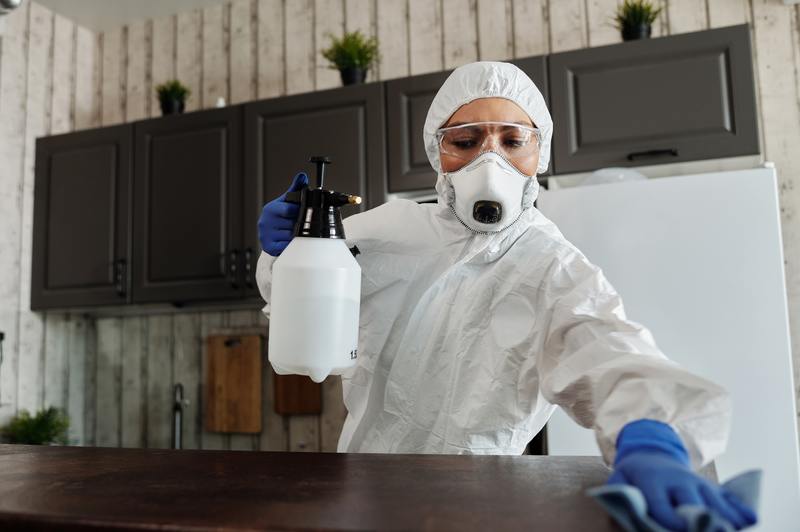Prior to the termination of unwanted pests in your life, you should spend some time to learn what are the important pest control equipment needed. This is a guideline that you will not allow to be overlooked in the course of implementing a successful pest management.

Equipment To Include On Your Checklist
While browsing and searching for the appropriate equipment to use, you may become overwhelmed by the number of results. Therefore, this tools list was created to make it easier for you to decide on what to prepare and purchase.
Narrowing down the most important pest control equipment from among the many options available.
Pest management is an essential service that is becoming more and more popular. Check out this list of must-have equipment for pest control services.
- Protective gear
- Gloves
- Baiting tools (traps and repellents)
- UV flashlight and Safety eyewear
- Foamers
- Foggers
- Respirator
- Duster
1. Protective gear
Pest control is a potentially hazardous activity. Technicians will deal with stinging insects and dangerous rodents, among other things.
The most important aspect of the job is to ensure that you are fully equipped with the appropriate safety equipment.
Coveralls, safety glasses, hand protection, earmuffs, masks, and first aid materials are all examples of appropriate protective equipment. If burns or other accidents occur, these items should be immediately accessible.
2. Gloves
Gloves must be long enough to reach the elbow and completely cover the arm. As a practical matter, you can ensure the safety as well as compliance with the law, as these gloves are also required by law for pest control staff.
3. Baiting tools (traps and repellents)
Pests must first be identified and tracked down before they can be dealt with. Bait attracts unwanted prey to traps, which can then be humanely removed or poisoned if that is the most ethical method.
Pest repellents work by preventing pests from ever setting up territory in the first place.
If you’re looking for a more environmentally friendly pest-control alternative, consider neem oil. There are steps on how to use neem oil for pest control
4. UV flashlight and safety eyewear
With a flashlight, you can find the whereabouts of the pests by spotting urine and droppings in the surrounding area. It can be used to track the pests’ trails and identify areas where they are most frequently found.
However, UV light can cause damage to human eyes, so you’ll need to provide proper eye protection as well.
5. Foamers
Pests and rodents typically live in hard-to-reach areas, so you must be capable of reaching them. Foamers use air to make chemical solutions foam, activating the ingredients.
You can add a foaming agent to the pesticide solution and shake the sprayer to activate the foam. Then, spray pesticide behind cabinets, under the floor, and in other hard-to-reach areas with the fine nozzle.
6. Foggers
Foggers are devices that are used to control the humidity in a space. Certain pests are sedated as a result of this procedure, making them easier to deal with.
7. Respirator
When there is a long-term exposure to hazardous materials, the need for a respirator is even greater. You can choose between the types of respirators for pesticide users including air-purifying and atmosphere-supplying.
8. Duster
Pesticide duster should be included in the toolkit of every pest control technician. The pesticides are delivered into cracks, crevices, and other troublesome areas with little effort on their part.
They simply add the powder and squeeze or pump the bulb. Using this method, you can effectively eliminate all types of flying and crawling pests, and it is also a great way to penetrate bee nests, termite infestation and other types of insect infiltrations.
Pesticide Safe-Use Reminders
- When using pesticides, make sure to wear protective clothing. In addition to any other protective clothing or equipment required by the label, consider wearing a long-sleeved shirt, long pants, and closed-toe shoes.
- Pesticides should be mixed outside or in well-ventilated areas.
- To avoid storing or disposing of excess pesticide, only mix what you need to use in the short term. Excessive use will be risky, so you might ask this question, how frequently can you have indoor pest control?
Review this article because it is a great guide that will essentially regulate your pest control practices. - Pesticide spills can happen at any time thus, a supply of absorbent paper towels and non-absorbent gloves is necessary in the event of a spill. The pesticide may spread if you use too much water, which is damaging to the environment.
- Personal items, such as toys, clothing and tools should be kept out of harm’s way while being sprayed to prevent contamination.
- Ensure adequate ventilation when using pesticides indoors.
- Avoid windy weather and close your home’s doors and windows when using pesticides as a spray or dust outside.
- Wash your hands thoroughly after using pesticides.
Conclusion
The use of the proper equipment for targeting pesticides and other solutions results in better control, less waste, and a lower risk of accidentally poisoning people and pets.
Further to that, pest control technicians must adhere to the safety precautions indicated on pesticide and chemical product labels. You could pass this list along to others and provide an answer to the question “what are the important pest control equipment.”
This has been a friendly reminder that you must be fully equipped to combat pests in your life.
